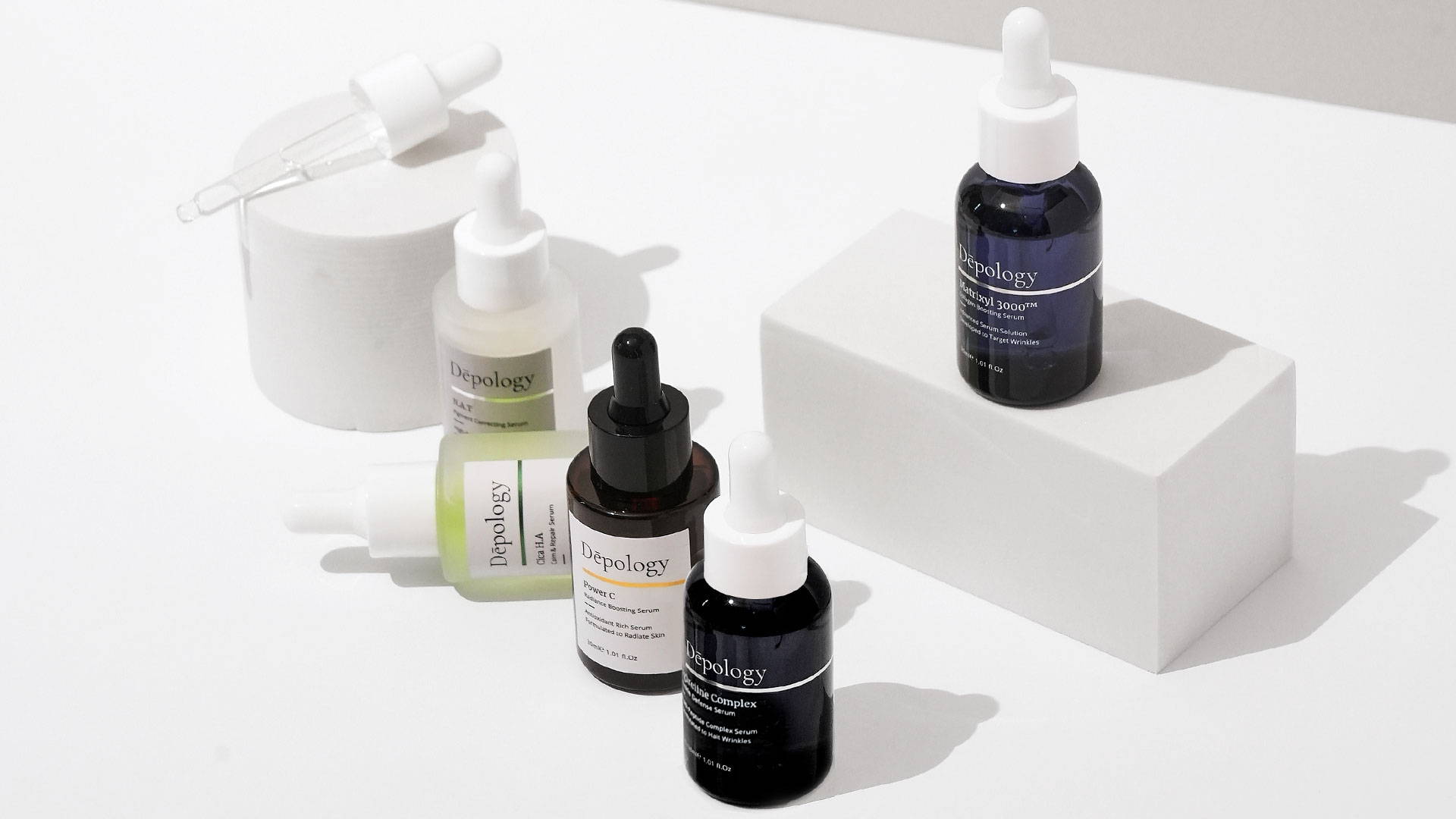
Microneedling vs. Laser: Which Is Right for You?
In this time when everyone is on the hunt for flawless skin, we have been gifted with a skincare industry full of many scientific and technological advancements. With so many thrilling new treatment options in the beauty space, it can be hard to know where to begin looking to pursue a more youthful and vibrant complexion.
We know how easily the abundance of amazing products and treatments can seem overwhelming, but Dēpology will always point you in the right direction. Today, we’ll look at two of our favorite treatments for skin resurfacing: microneedling and laser therapy.
Both microneedling and laser therapy are aesthetic treatments that remove dead skin cells and rejuvenate the skin's surface. However, these two procedures operate very differently and do not deliver similar results to all skin types.
We’ll break down the pros and cons of each treatment and help you determine which is right for you!
What’s the Difference Between Microneedling and Laser Therapy?
Both treatments can heal cosmetic concerns, including acne scarring and general rejuvenation. Although they are both forms of skin-resurfacing, microneedling and laser therapy have one large difference that all comes down to how they operate.
Microneedling
Microneedling is a mechanical method of skin resurfacing during which a medical professional uses a tool to puncture thousands of microchannels into the skin. These prick points are microscopic but are just enough to trigger the skin’s injury response, forcing the skin to launch the healing process and initiate the production of collagen and elastin (two proteins that give the skin rigidity and flexibility).
Microneedling can also be referred to as collagen induction therapy (CIT) or percutaneous collagen induction (PCI). This process heals damaged skin with new tissue and can lead to more youthful, firmer skin overall.
Microneedling procedures are most frequently used to target the skin's surface, but they can also utilize longer needles to penetrate deeper layers of the skin to help heal issues such as stretch marks, minor scarring, or deep wrinkles. Microneedling is most frequently used on the face but can also treat the scalp and body.
Laser Therapy
Laser therapy is a facial rejuvenation treatment used almost exclusively on the face. Alternatively to physical microneedling, lasers use light energy to resurface the skin, which allows for much more targeted treatment. Lasers can directly treat dark spots or broken red veins without disrupting the surrounding skin tissue.
There are two types of lasers between which your dermatologist will decide which is best for your unique skin: ablative or nonablative. An ablative laser removes the outermost layer of skin, heats the dermis, and promotes collagen production.
As that skin heals and repairs, it will be even firmer, smoother, and more even than before. A non-ablative laser also stimulates collagen production but does not damage the outer layer of skin and thus is less effective in treating deeper-rooted skin concerns.
Depending on the type of laser your dermatologist recommends, you can target specific skin concerns such as acne scarring and hyperpigmentation (dark spots) or simply help rejuvenate and rebuild your skin barrier by stimulating collagen production and the growth of younger, healthier skin cells.
What Are The Pros and Cons of Microneedling vs. Laser Treatment?
Microneedling Pros
- Can have a relatively quick recovery time - Following treatment, there will be a light sunburned appearance on the skin for only about one to two days with very few potential side effects.
- Can increase the effectiveness of skincare products - The microchannels created by the microneedling tool can allow skincare products to penetrate deeper levels of the skin and work more effectively.
- Can be done at home - Everyday users can purchase microneedling tools for at-home use. These tools will not be as powerful as those used in a clinician’s office but are an accessible option for those who prefer at-home treatment and want to boost their collagen production without office visits.
- Can be used for all skin types - Since microneedling does not use heat to operate, it can be safely used on patients with darker skin tones without the risk of discoloration.
Microneedling Cons
- Can have slow visible results - Microneedling works slowly over time with consistent use but will only provide subtle changes over its first few uses. It may require weeks and several sessions before any significant improvement can be identified.
- Can have the risk of scarring with at-home treatment - Although it is convenient to have the option of at-home microneedling treatment, it does come with the risk that scarring or infection could occur if used incorrectly.
- Can not be used by those experiencing bacterial skin infections - For those with active infections or treating conditions such as psoriasis, acne, or eczema are not recommendable candidates for this treatment as bacteria can enter the microchannels and cause further infections.
Laser Therapy Pros
- Can provide faster results than microneedling - Lasers provide more dramatic changes to the skin, resulting in more evident changes following each treatment session.
- Can have long-lasting results - Following a successful treatment and healing period, skin can continue to improve for up to a year, and improvement may last several years.
- Does not require skin incisions - Unlike microneedling, laser resurfacing uses heat to treat the skin and thus does not require any skin puncturing to work effectively, reducing the risks of any scarring from the procedure.
Laser Therapy Cons
- Can be more expensive than microneedling - Microneedling can cost, on average, $200 to $700 per session, while the average cost for a laser treatment ranges between $1200 and $2000.
- Can have the risk of skin discoloration for those with darker skin tones - Due to the laser’s use of heat, there is a higher risk of discoloration in patients with deeper skin tones.
- Can have a slower recovery period than microneedling - Microneedling only requires a day or two of recovery. In contrast, laser treatments can leave wounds, swelling, and redness that require several days up to two weeks to recover.
- Can have more side effects - With the greater reward of quicker results comes greater risks, including temporary darkening or bruising.
What Is the Aftercare for Microneedling and Laser Therapy?
As with any procedure, aftercare is extremely important, even if the treatment has a relatively short downtime or recovery window.
Microneedling
Carefully adhere to the following instructions for the smoothest experience after a session of professional microneedling:
- Avoid extensive sun exposure for up to two weeks. Wear SPF 30 (minimum) sunscreen daily. Sunlight can damage and discolor sensitive skin.
- Avoid touching or scratching the sensitive treatment areas.
- Avoid baths or swimming pools for two weeks. (Showers are okay.)
- Continue your skincare routine but avoid the following for at least 48 hours:
- Skincare products with active ingredients (hyaluronic or salicylic acid, vitamin C, retinol, etc.)
- Highly scented or fragranced skincare/shower products
- All makeup products
- Harsh cleansers
- Essential oils
Laser Therapy
A laser resurfacing session can result in raw, itchy skin at the specific point of treatment which can take up to two weeks to heal fully. During those two weeks, adhere to the following rules:
- Avoid makeup, skincare products, and sunscreen for the first two weeks of healing. You can use a saline solution to cleanse the area up to five times daily. You may be able to apply a moisturizer, but it must be cleared with your doctor to ensure it is safe to use first.
- Avoid prolonged sun exposure even beyond two weeks post-treatment. Avoid unnecessary sun exposure even for months following treatment. After the treatment area is fully healed, always apply an SPF 30 when going into the sun, even for a short period.
- Avoid swimming pools, hot tubs, or anywhere that could infect your skin with bacteria.
Can Laser Therapy and Microneedling Be Used Together?
Microneedling and laser resurfacing procedures can be combined for an alternated treatment plan or can even be done one after the other. However, there is a risk of higher skin sensitivity when undergoing both procedures in a short time due to the sensitivity of the face skin.
As with any clinical procedure, it is best to discuss with your aesthetician or dermatologist if a combination of laser and microneedling would be best for you.
What’s Right for You?
As we recap, microneedling is best for those who want younger-looking, more vibrant skin overall. If you seek exfoliation and rejuvenation, microneedling can be a more accessible, affordable treatment.
If you are seeking more specific treatment for spot corrections and want quicker, more aggressive results, laser therapy will certainly help treat deeper skin concerns if you are willing to wait through the recovery period.
Remember that microneedling will be the treatment with the least risk for anyone with a deeper skin tone. While you are still deciding, Dēpology’s Anti-Wrinkle Eye and Smile Microneedle Patches can give you the luxury of microneedling with the ease and comfort of a simple patch. Each patch has 1000 microneedles, formulated with key ingredients to help smoothen your skin and give it renewed radiance.
Looking for more ways to rejuvenate your skin? Explore Dēpology’s collection of innovative Korean skincare formulas here.
Sources:
Microneedling: Advances and Widening Horizons | PMC
Laser Skin Resurfacing | Cleveland Clinic
Skin Needling Procedure USes Body’s Natural Healing Process | MayoClinic













